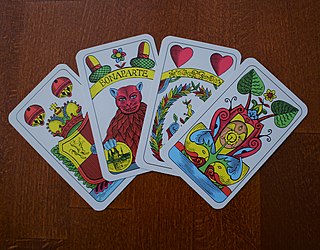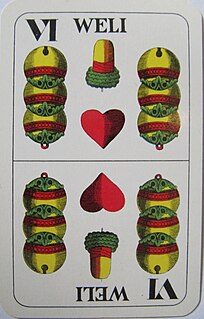Rules
The game is played with a 52-card pack of French playing cards. The Ace is the highest card; the Two the lowest.
At the beginning of a game, the banker places an agreed fixed amount on the table in front of him. The other players now bet against it, but the sum of the opponents' bets must not exceed "half" the amount in the bank.
The banker shuffles, offers the pack for cutting and plays the first card face up to the table and then deals the next three cards are to the other players. If his opponents can beat the banker's card, i.e. if there is a card of the same suit and higher rank than the banker's among the three punters' cards, the opponents win in the ratio 2:1.
If the opponents cannot beat the banker's card, the banker collects the bets, thus increasing the bank total. The banker may not, however, take any winnings from the bank unless he surrenders the role of banker.
If the bank goes bust (gesprengt), i.e. there is no more money in the bank, the banker has to give the bank up and the player to his left becomes the next banker.
If the amount in the bank after a game is at least three times the original deposit, the banker may hold the bank for one last 'trick round'. After this game, the banker must hand over the bank to his left neighbour. If the bank is not bust after this round, the amount in the bank belongs, naturally, to the banker.

Blackjack is the most widely played casino banking game in the world. The game is played with decks of 52 cards and is an American descendant of a global family of banking games known as Twenty-One. This family of card games also includes the British game of Pontoon and the European game, Vingt-et-Un.
Pai gow poker is a version of pai gow that is played with playing cards, instead of traditional pai gow's Chinese dominoes. The game of pai gow poker was created in 1985 in the United States by Sam Torosian, owner of the Bell Card Club.

Baccarat or baccara is a card game played at casinos. It is a comparing card game played between two hands, the "player" and the "banker". Each baccarat coup has three possible outcomes: "player", "banker", and "tie". There are three popular variants of the game: punto banco, baccarat chemin de fer, and baccarat banque. In punto banco, each player's moves are forced by the cards the player is dealt. In baccarat chemin de fer and baccarat banque, by contrast, both players can make choices. The winning odds are in favour of the bank, with a house edge no lower than around 1 percent.

Basset, also known as barbacole and hocca, is a gambling card game that was considered one of the most polite. It was intended for persons of the highest rank because of the great losses or gains that might be accrued by players.

Faro, Pharaoh, Pharao, or Farobank is a late 17th-century French gambling card game. It is descended from Basset, and belongs to the Lansquenet and Monte Bank family of games due to the use of a banker and several players. Winning or losing occurs when cards turned up by the banker match those already exposed.

Card counting is a blackjack strategy used to determine whether the player or the dealer has an advantage on the next hand. Card counters are advantage players who try to overcome the casino house edge by keeping a running count of high and low valued cards dealt. They generally bet more when they have an advantage and less when the dealer has an advantage. They also change playing decisions based on the composition of the deck.
Teen patti is a gambling card game that originated in the Indian subcontinent and is popular throughout South Asia. It originated in the English game of three-card brag, with influences from poker. It is also called flush or flash in some areas.
The following is a glossary of poker terms used in the card game of poker. It supplements the glossary of card game terms. Besides the terms listed here, there are thousands of common and uncommon poker slang terms. This is not intended to be a formal dictionary; precise usage details and multiple closely related senses are omitted here in favor of concise treatment of the basics.

Monte Bank, Mountebank, Spanish Monte and Mexican Monte, sometimes just Monte, is a Spanish gambling card game and was known in the 19th century as the national card game of Mexico. It ultimately derives from basset, where the banker (dealer) pays on matching cards. The term "monte" has also been used for a variety of other gambling games, especially varieties of three-card poker, and for the swindle three-card monte.

The following is a glossary of terms used in card games. Besides the terms listed here, there are thousands of common and uncommon slang terms. Terms in this glossary should not be game-specific, but apply to a wide range of card games. For glossaries that relate primarily to one game or family of similar games, see Game-specific glossaries.

Bohemian Schneider is a card game for two people, which is played with a German-suited Skat pack of 32 cards. Because it is a simple trick-taking game, it is often played by older children and is recommended for age 8 upwards. It was probably developed in Bohemia and spread from there across the south German region and Austria. The game is sometimes called Bohemian Tailor, Schneider being German for "tailor".

Mauscheln, also Maus or Vierblatt, is a gambling card game that resembles Tippen, which is commonly played in Germany and the countries of the old Austro-Hungarian Empire.

Tempeln, also known as Meine Tante – Deine Tante, and its 32-card version, known as Naschi Waschi, German Pharaoh, Stoß or Süßmilch, are very simple historical, German, gambling card games played with French or German playing cards. They differ from the more complex Basset and Faro in that they omit aspects such as lappé, paroli, etc.
Macao is an old, European gambling card game played with French playing cards that is related to Baccarat. It was first mentioned in 1783 and may have originated in Hungary or Italy. It was described as being popular with the soldiers of the Austro-Hungarian Empire during the 19th century, although the game was later banned as a game of chance.
Silesian Lottery, also called Card Lottery (Kartenlotterie), Card Tombola (Kartentombola), Großes Los, Grüne Wiese or Bullermännchen, is a simple, German, game of chance and gambling card game, that is played with two packs of 32 Bavarian-pattern or French-suited playing cards.

Blind Hookey, also known as Dutch Bank, Banker and Broker and Honest John, is a simple game of chance using playing cards. The game is popular in Germany where it is known as Häufeln, Bockspiel or Päckchen wenden, after the little packets of cards used.

Twenty-One, formerly known as Vingt-Un in Britain, France and America, is the name given to a family of popular card games of the gambling family, the progenitor of which is recorded in Spain in the early 17th century. The family includes the casino games of blackjack and Pontoon as well as their domestic equivalents. Twenty-One rose to prominence in France in the 18th century and spread from there to Germany and Britain from whence it crossed to America. Known initially as Vingt-Un in all those countries, it developed into Pontoon in Britain after the First World War and blackjack in Canada and the United States in the late 19th century, where the legalisation of gambling increased its popularity.

Bruus, formerly Brausebart or Brusbart, is a very old north German card game for four players in two teams of two. It was once highly popular but has since died out except for a few pockets in the state of Schleswig-Holstein. As Brusbart, it was the ancestor of a family of similar games in northern Europe, including Swedish Bräus and Danish Brus which are still played today. Bruus features 'daring and tormenting' which has been said to give the game a certain charm. Once considered the national game of Hamburg, Bruus is a descendant of Karnöffel, the oldest identifiable European card game in the history of playing cards with a continuous tradition of play down to the present day. The game is named after the Bruus or Brusbart, once its top card, but now its second-highest trump.

Pontoon, formerly called Vingt-Un, is a card game of the banking family for three to ten players and the "British domestic version of Twenty-One," a game first recorded in 17th-century Spain, but which spread to France, Germany and Britain in the late 18th century, and America during the early 19th century. It is not, as popularly supposed, a variant of Blackjack nor is Pontoon derived from Blackjack, but both are descended from the early British version of Vingt-Un. In Britain, it first became known as Pontoon during the First World War, the name apparently being a soldier's corruption of its former French name. The games has no official rules and varies widely from place to place. It is a popular family game, but also widely played by children, students and in the armed forces. In 1981, Pontoon was the 3rd most popular card game in Britain after Rummy and Whist. It has been described as "an amusing round game and one which anyone can learn in a few minutes."

Gilten or Giltspiel is a "very old" Austrian card game for four players, playing in partnership, with 32 German-suited cards of the William Tell pattern. Despite its age, it is still played locally in parts of Austria today. It is a trick-taking game which involves betting on the outcome and certain card combinations.
















